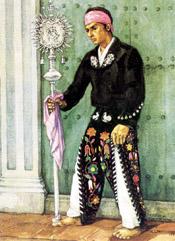Atanasio Tzul
Atanasio Tzul was a leader of the Guatemalan indígenas , the Maya K'iche ' and the symbolic figure of the uprising Levantamiento indígena de Totonicapán de 1820 , by which the Spanish rule was suspended for 29 days and the independent "kingdom" " Totonicapán en el Reino de Guatemala" “Was created.
Life
Tzul came from Cantón Paquí , in Totonicapán , from a family of soap makers in Barrio Linkah . He was married to Felipa Soc. There are no records of his birth and death dates, all that is certain is that he was born in the 18th century and died in the early 19th century.
Political appearance
Tzul's public appearance began in 1813 when he became principal of the town (Parcialidad) Linkah and learned the content of the Constitution of Cádiz (1812), according to which the natives (indigenous) should be granted the same rights as the Spaniards and the Ladinos. The chiefs and councilors (Principales, Concejales) of San Miguel Totonicapán then, under the leadership of Tzul and Lucas Aguilar (Akilal), wrote a letter to the king to thank him because they believed that he was behind the decision. In 1816, as Alcalde, Tzul limited himself to collecting only seven reales (taxes) in San Miguel Totonicapán, for the needs of the community and the salaries of the clergy and officials.
In 1820 he was recognized as the unofficial representative of the Parcialidades Linkah, Pachah, Uculjuyub, Chiché and Tinamit. In the same year he allied himself with Lucas Aguilar with the aim of abolishing church taxes and tribute. Together they fought against the power of the Spanish colonial administration, which was represented in the region by the General Captain of Guatemala , the Archbishop of Guatemala , Ramón Casaus y Torres , the orders , as well as the elite of the mestizo and the Kaziquen of Totonicapán. These groups stood out from the local population and clung to their privileges. The tributes had been abolished in 1811 by the Constituent Assembly of the Cortes of Cadiz , but were again demanded by Ferdinand VII .
During Lent in 1820, when it became known that Ferdinand VII had reinstated the absolutist constitution, Aguilar and Tzul tried to confirm this rumor by talking to the Alcalde Mayor . On July 9, 1820, on the occasion of the celebration of the “New Constitution”, Tzul took part in Spanish clothes, with a coat (casaca), tricorn hat (sombrero al tres), ornamental sword (espadín), walking stick (bastón) and medal of honor. However, on the night of July 12, the nobles and leaders of the revolt made Tzul and his wife kings and symbolically crowned them with the crowns of Saints San José and Santa Cecilia . The political and military inability of the Spanish rulers, the first attempts at political autonomy and the competition between Spanish officials led to the success of the uprising. The insurgents abolished the tribute, eliminated the Alcalde Mayor , José Manuel Lara de Arrese , and founded their own government. And for a few days between July and August 1820, Tzul ruled as a representative (Rey y señor del Reino de Totonicapán) of a local government.
However, the movement was soon suppressed militarily. Mestizo militias (milicianos ladinos) came to the area by the thousands. The leader of the K'iché was flogged for nine days and then imprisoned in Quetzaltenango . On January 25, 1821, he and other leaders signed a pardon, which was approved on March 1, 1821, after the residents of Totonicapán had demonstrated for it.
legacy
According to tradition from Totonicapán, Tzul was lord of areas of the Paquí mountain region, which he converted into communal property. An important achievement of his rule was the fight against taxes imposed by the general captainate. He is therefore considered a champion of the rights of the local Quiché (K'iche '). The successors as Alcalde Comunal in the 48 cantons of Totonicapán also see it as a great honor to follow the ideas of Antasio Tzul.
In his memory, the sculptor Rodolfo Galeotti Torres created a statue in Totonicapán, the Monumento a Atanasio Tzul and in Zona 12 of the Ciudad de Guatemala the street Calzada Atanasio Tzul was built at the end of the 20th century .
literature
- Castro Gutiérrez; Alonzo Alvarado; Herrera Juarez; Méndez Lacayo; Petrona del Rosario; Natalia Marina; Maridalia; Luis Fernando: La rebelión de Atanasio Tzul: legado histórico en Paqui, Totonicapán. Universidad de San Carlos de Guatemala, Centro Universitario de Occidente, Quetzaltenango, Guatemala 2011. [1] Retrieved July 25, 2017.
- A. Móbil: 100 Personajes Históricos de Guatemala. Serviprensa Centroamericana, Guatemala 1991.
- A. Móbil: Historia del Arte Guatemalteco. Serviprensa Centroamericana, Guatemala 2002.
Web links
- wikiguate.com , accessed July 25, 2017.
- aprende.guatemala.com , accessed July 25, 2017.
Individual evidence
- ↑ a b c d e f Móbil 1991.
- ↑ a b c Atanasio Tzul. In: AFEHC, Historia centroamericana, accessed July 25, 2017.
- ↑ a b c d Castro Gutiérrez; Alonzo Alvarado; Herrera Juarez; Méndez Lacayo, 2011: 9.
- ↑ Atanasio Tzul. In: Democracia Multicultural. Retrieved July 25, 2017.
- ↑ mobile of 2002.
| personal data | |
|---|---|
| SURNAME | Tzul, Atanasio |
| BRIEF DESCRIPTION | Leader of the Indeginas |
| DATE OF BIRTH | 18th century |
| DATE OF DEATH | 19th century |
